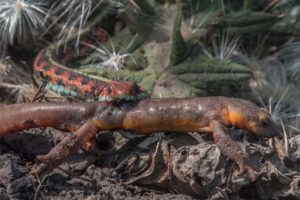How do I tell a gopher snake from a rattlesnake?
Ah, the eternal question of the Bay Area hiker! We have only one medically significant snake species here in the Bay Area and that is the western rattlesnake (Crotalus oreganus), but a few other resident snake species look pretty similar, including the commonly seen and indefatigable gopher snake (Pituophis catenifer). Rattlesnakes will not strike unless cornered or provoked, but it’s always helpful to know whether that snake sunning itself on the trail might be able to harm you.
While one trait is a dead giveaway — the presence of a rattle — you might not be able to see it, or the snake may be too young to have grown one yet. Also, pattern and color are quite variable (within a certain range of brown, tan, and sometimes green) in both species, so I’m focusing on more consistent traits.
I’ll be linking to some photos of my own, as well as photos from the invaluable California Herps website as examples. The latter is a wonderful resource.
Body shape
The first thing I look at when I spot a possible gopher snake or rattlesnake. The snake body is, of course, just a long tube (let’s not use the demeaning term “nope rope” here), but there are lots of subtle variations. A snake’s cross section determines (or is determined by?) its feeding and locomotion habits, and there is more body shape diversity among snakes than you might imagine.
Rattlesnakes are, for the most part, ambush predators. They generally lie in wait and strike at prey (lizards when young, graduating to small mammals as adults), and have a wide, thick body. Gopher snakes are generalists, more likely to search out prey rather than relying on ambush, and they have a sleeker build — really kind of squarish cross section with sides that are almost vertical. Learn to recognize the basic shape of both species and you can quickly narrow down the likely species.

Head shape
It’s a commonly repeated myth that only venomous snakes have triangular heads. While there is some truth to this, especially in the United States, like most things in nature, things are not that simple.
Rattlesnakes are vipers, and a viper’s venom glands (basically modified saliva glands) reside on the sides of its head, contributing to that trademark triangle shape. And as vipers make up the vast majority of commonly seen venomous snakes in the United States, if the snake you see has one, there’s a good chance it’s venomous. The other major family of venomous snakes, the elapids (cobras, sea snakes, mambas, etc) are represented in the United States by several species of coral snakes in the southern parts of the country. They do not have triangular heads.
However, plenty of other snakes, including gopher snakes and garter snakes, will take advantage of their loosely connected jaw bones and flatten out their heads when threatened, making them look awfully triangular at first glance. So if the snake you encounter looks perturbed, don’t count solely on head shape when you ID it.
Tail
“Oh ho,” you say to me, “but if the snake is shaking its tail then it has got to be a rattler!”
“Not necessarily,” would be my response. Because not only does a gopher snake morph its head to mimic that of a rattler’s, it will also coil up in a similar fashion and shake its tail at a good clip. Add some dry grass or dry leaves to the tail’s vicinity and the whole act can be mighty convincing. Rather than rely on tail shaking behavior, you’ll want to look for physical characteristics here. An adult rattlesnake will usually have a nice-sized rattle, so that’s easy, but a young rattlesnake may only have a single button. Look instead for rings at the base of a stubby tail (rattlesnake), or a long tapered tail which ends in a point (gopher snake).
Other clues
- Rattlesnakes have heat sensing pits below their eyes which look like a larger pair of nostrils, and vertical cat-like pupils (see photo at top of page) but please don’t lean in close to verify this.
- Gopher snakes, especially when basking on a road or trail, tend to maneuver their bodies into a series of small curves, whereas rattlesnakes prefer longer, broader curves.
What to do if it’s a rattlesnake
If the snake you encounter on the trail has a few of the rattlesnake traits described above, then yes, it’s probably a rattler. No big deal, it won’t chase after you — just give it a wide berth as you pass by, making sure it has room to escape, and count yourself lucky to have seen such an awesome creature. Any attempt to move, harass, or kill the rattlesnake will significantly increase your chances of getting bitten, and both you and your bank account will not be happy with that outcome.
But what if the rattlesnake is in your yard, wouldn’t that be a situation where killing it makes sense? Well, as stated above, you’re playing with fire if you try to kill a rattlesnake, and even a dead one poses serious risks. Best to leave it be or shoo it away with a long stick, such as a broomstick, and warn your family about it. Perhaps call a professional snake removal service if necessary.
The presence of a snake in your yard, however, is merely a symptom: the issue is that your house or yard is attractive to snakes. Keep your yard free of debris, your plants and grass well maintained, and humanely reduce the number of nearby rodents and you won’t be giving snakes much reason to stick around. Both Save the Snakes and Advocates for Snake Preservation have tips for this.





